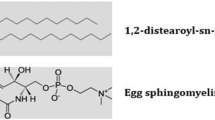Abstract
The interaction between two peptides previously selected by phage display to target apoptotic cells and phospholipidic models of these cells (liposomes or micelles made of 1,2-dipalmitoyl-sn-glycero-3-phosphocholine (DPPC) and/or 1,2-dipalmitoyl-sn-glycero-3-phospho-l-serine (DPPS, phosphatidylserine analog) was studied by the simple analysis of the changes induced on the proton NMR chemical shifts of the peptides. Our approach which does not need healthy and/or apoptotic cells for assessing the affinity of different peptides is fast and efficient and requires small amounts of peptide to determine the association constant, the interacting protons, and the number of interaction sites. The micellar model gave more reliable results than the liposomal one. The preferential interaction of the peptide with DPPS was evidenced by the change of the chemical shifts of specific amino acids of the peptides. Our micellar model is thus well suited to mimic apoptotic cells.









Similar content being viewed by others
References
MacFarlane M, Williams AC (2004) EMBO Rep 5(7):674–678. doi:10.1038/sj.embor.7400191
Laufer EM, Reutelingsperger CPM, Narula J, Hofstra L (2008) Basic Res Cardiol 103:95–104. doi:10.1007/s00395-008-0701-8
Friedlander RM (2003) N Engl J Med 348(14):1365–1375
Mallat Z, Tedgui A (2001) Circ Res 88:998–1003. doi:10.1161/hh1001.090571
Fadok VA, De Cathelineau A, Daleke DL, Henson PM, Bratton DL (2001) J Biol Chem 276:1071–1077. doi:10.1074/jbc.M003649200
Van Tilborg GAF, Mulder WJM, Deckers N, Storm G, Reutelingsperger CPM, Strijkers GJ, Nicolay K (2006) Bioconjugate Chem 17:741–749. doi:10.1021/bc0600259
Baskic D, Popovic S, Ristic P, Arsenijevic NN (2006) Cell Biol Int 30:924–932. doi:10.1016/j.cellbi.2006.06.016
Koulov AV, Hanshaw RG, Stucker KA, Lakshmi C, Smith BD (2005) Isr J Chem 45:373–379. doi:10.1560/6AD4-LC9G-P57M-BE5Y
Van Tilborg GAF, Vucic E, Strijkers GJ, Cormode DP, Mani V, Skajaa T, Reutelingsperger CP, Fayad ZA, Mulder WJ, Nicolay K (2010) Bioconjug Chem 21(10):1794–1803. doi:10.1021/bc100091q
Hong H-Y, Choi JS, Kim YJ, Lee HY, Kwak W, Yoo J, Lee JT, Kwon T-H, Kim I-S, Han H-S, Lee B-H (2008) J Control Release 131:167–172. doi:10.1016/j.jconrel.2008.07.020
Thapa N, Kim S, So I-S, Lee B-H, Kwon I-C, Choi K, Kim I-S (2008) J Cell Mol Med 12(5A):1649–1660. doi:10.1111/j.1582-4934.2008.00305.x
Laumonier C, Segers J, Laurent S, Alain M, Coppée F, Belayew A, Vander Elst L, Muller RN (2006) J Biomol Screen 11(5):537–545. doi:10.1177/1087057106288220
Burtea C, Laurent S, Lancelot E, Ballet E, Murariu O, Rousseaux O, Port M, VanderElst L, Corot C, Muller RN (2009) Mol Pharm 6(6):1903–1919. doi:10.1021/mp900106m
Wallner J, Lhota G, Jeschek D, Mader A, Vorauer-Uhl K (2013) J Pharm Biomed Anal 72:150–154. doi:10.1016/j.jpba.2012.10.008
Abdiche YN, Myszka DG (2004) Anal Biochem 328:233–243. doi:10.1016/j.ab.2004.01.018
Baird CL, Courtenay ES, Myszka DG (2002) Anal Biochem 310:93–99. doi:10.1016/S0003-2697(02)00278-6
Kapty J, Banman S, Goping IS, Mercer JR (2012) J Biomol Screen 17(10):1293–1301. doi:10.1177/1087057112453313
Cypionka A, Stein A, Hernandez JM, Hippchen H, Jahn R, Walla PJ (2009) Proc Natl Acad Sci USA 106(44):18575–18580. doi:10.1073/pnas.0906677106
Campillo CC, Schroder AP, Marques CM, Pépin-Donat B (2009) Mater Sci Eng C 29:393–397. doi:10.1016/j.msec.2008.08.001
Lasic DD (1993) Liposomes: from physics to applications. Elsevier, Amsterdam
Parac-Vogt TN, Kimpe K, Laurent S, Piérart C, VanderElst L, Muller RN, Binnemans K (2006) Eur Biophys J 35:136–144. doi:10.1002/ejic.200400187
Bartlett GR (1959) J Biol Chem 234:466–468
Barenholz Y, Amselem S (1993) Quality control assays in the development and clinical use of liposome-based formulation. In: Gregoriadis G (ed) Liposome technology: liposome preparation and related techniques, 2nd edn. CRC, Boca Raton, pp 527–616
Fielding L, Rutherford S, Fletcher D (2005) Magn Reson Chem 43:463–470. doi:10.1002/mrc.1574
Fielding L (2007) Prog Nucl Magn Reson Spectrosc 51:219–242. doi:10.2174/1568026033392705
Luo R-S, Liu M-L, Mao X-A (1999) Spectrosc Acta Part A 55:1897–1901
Acknowledgments
This work was supported by the Walloon Region (program First spin-off), the FNRS (Fonds National de la Recherche Scientifique), the UIAP VII and ARC Programs (AUWB-2010—10/15-UMONS-5) of the French Community of Belgium. The authors thank the Center for Microscopy and Molecular Imaging (CMMI, supported by the European Regional Development Fund and the Walloon Region).
Conflict of interest
The authors declare no competing financial interest.
Author information
Authors and Affiliations
Corresponding author
Electronic supplementary material
Below is the link to the electronic supplementary material.
775_2014_1195_MOESM1_ESM.pdf
COSY spectrum of E3 peptide, COSY spectrum of E3 scramble peptide, COSY spectrum of R826 peptide, COSY spectrum of R826 scramble peptide, example of Z-average size of DPPC–DPPS (80–20 w/w) liposomes by intensity, example of Z-average size of DPPC liposomes by intensity, example of Z-average size of DPPC micelle by intensity, example of Z-average size of DPPS micelle by intensity (PDF 637 kb)
Rights and permissions
About this article
Cite this article
Van Koninckxloo, A., Henoumont, C., Laurent, S. et al. NMR chemical shift study of the interaction of selected peptides with liposomal and micellar models of apoptotic cells. J Biol Inorg Chem 19, 1367–1376 (2014). https://doi.org/10.1007/s00775-014-1195-5
Received:
Accepted:
Published:
Issue Date:
DOI: https://doi.org/10.1007/s00775-014-1195-5




